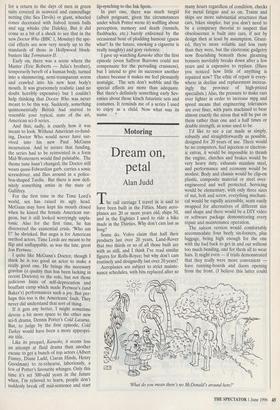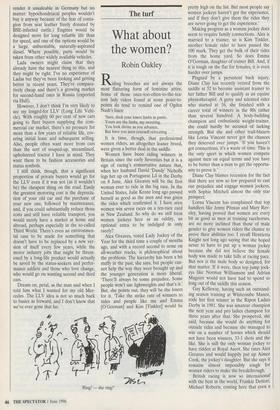Motoring
Dream on, petal
Alan Judd
The rail carriage I travel in is said to have been built in the Fifties. Many aero- planes are 20 or more years old, ships 50, and in the Eighties I used to ride a bike made in the Thirties. Why don't cars last as long? Some do. Volvo claim that half their products last over 20 years, Land-Rover that two thirds or so of all those built are with us still, and I think I've read similar figures for Rolls-Royce; but why don't cars routinely and designedly last over 20 years? Aeroplanes are subject to strict mainte- nance schedules, with bits replaced after so many hours regardless of condition, checks for metal fatigue and so on. Trains and ships are more substantial structures than cars, bikes simpler, but you don't need to be a conspiracy theorist to suspect that obsolescence is built into cars, if not by design then at least by assumption. Grant- ed, they're more reliable and less rusty than they were, but the electronic gadgetry now flourishing beneath those gleaming bonnets inevitably breaks down after a few years and is expensive to replace. (Have you noticed how little of anything is repaired now? The ethic of repair is every- where in decline and replacement increas- ingly the province of high-priced specialists.) Also, the pressure to make cars ever lighter in order to increase mpg and speed means that engineering tolerances are ever finer, with parts machined to bear almost exactly the stress that will be put on them rather than one and a half times or double strength, as some used to be.
I'd like to see a car made as simply, robustly and straightforwardly as possible, designed for 20 years of use. There would be no computers, fuel injection or electron- ic extras, it would be impossible to thrash the engine, clutches and brakes would be very heavy duty, exhausts stainless steel, and performance and economy would be modest. Body and chassis would be clip-on plastic, composite material or steel over- engineered and well protected. Servicing would be elementary, with only three sizes of nut, bolt and screw, everything mechani- cal would be rapidly accessible, seats easily swapped for alternatives of different size and shape and there would be a DIY video or software package demonstrating every repair and maintenance operation.
The saloon version would comfortably accommodate four beefy six-footers, plus luggage, being high enough for the one with the bad back to get in and out without too much bending, and for them all to wear hats. It might even — if trials demonstrated that they really were more convenient — have running-boards and doors opening from the front. (I believe this latter could 'What do you mean there's no McDonald's around here?' render it unsaleable in Germany but no matter: hypochondriacal peoples wouldn't buy it anyway because of the fear of conta- gion from seat leather freely donated by BSE-infected cattle.) Engines would be designed more for long reliable life than for speed, and one of the options would be a large, unburstable, naturally-aspirated diesel. Where possible, parts would be taken from other widely available vehicles.
Lada owners might claim that they already have the nearest thing to this, and they might be right. I've no experience of Ladas but they've been looking and getting better in recent years. They're compara- tively cheap and there's a growing market for second-hand ones in Russia (exported via Hull).
However, I don't think I'm very likely to see my longed-for LLV (Long Life Vehi- cle). With roughly 60 per cent of new cars going to fleet buyers supplying the com- mercial car market, there's no pressure for more than a few years of reliable life, cov- ering initial lease and subsequent selling. Also, people often want more from cars than the sort of souped-up, streamlined, upholstered tractor I have in mind. They want them to be fashion accessories and status symbols.
I still think, though, that a significant proportion of private buyers would go for the LLV even if it was not (as it wouldn't be) the cheapest thing on the road. Easily the greatest motoring cost is the deprecia- tion of your old car and the purchase of your new one, followed by maintenance, and, if you could substantially reduce those costs and still have reliable transport, you would surely have a market at home and abroad, perhaps especially in the so-called Third World. There's even an environmen- tal case to be made for something that doesn't have to be replaced by a new ver- sion of itself every few years, while the motor industry jobs that might be threat- ened by a long-life product would actually be saved by the status-seekers and perfor- mance addicts and those who love change, who would go on wanting second and third cars.
Dream on, petal, as the man said when I told him what I wanted for my old Mer- cedes. The LLV idea is not so much back to basics as forward, and I don't know that we've ever gone that far.



























































 Previous page
Previous page